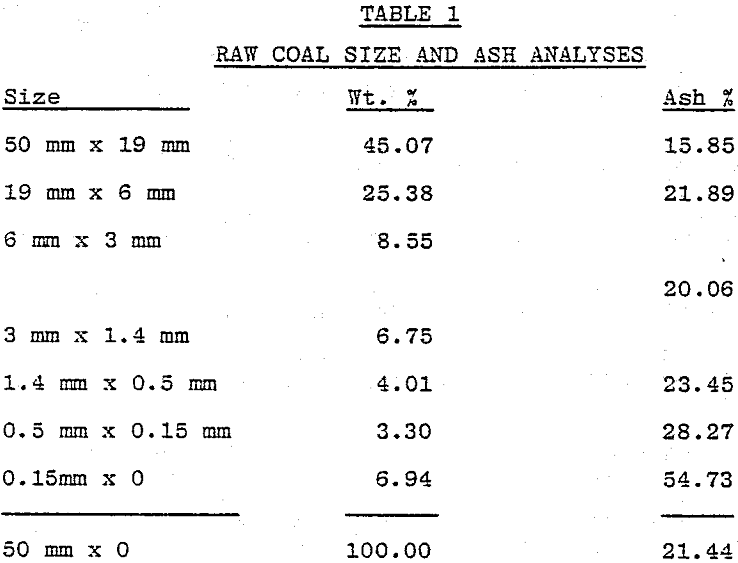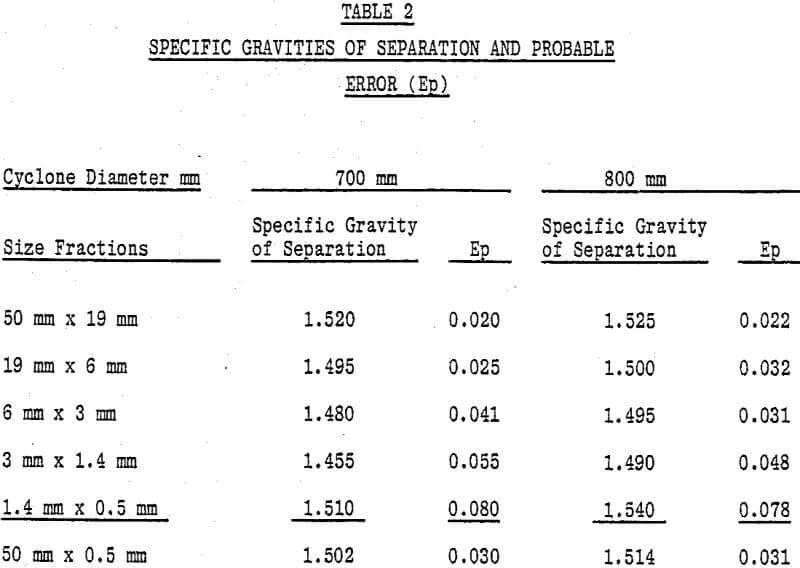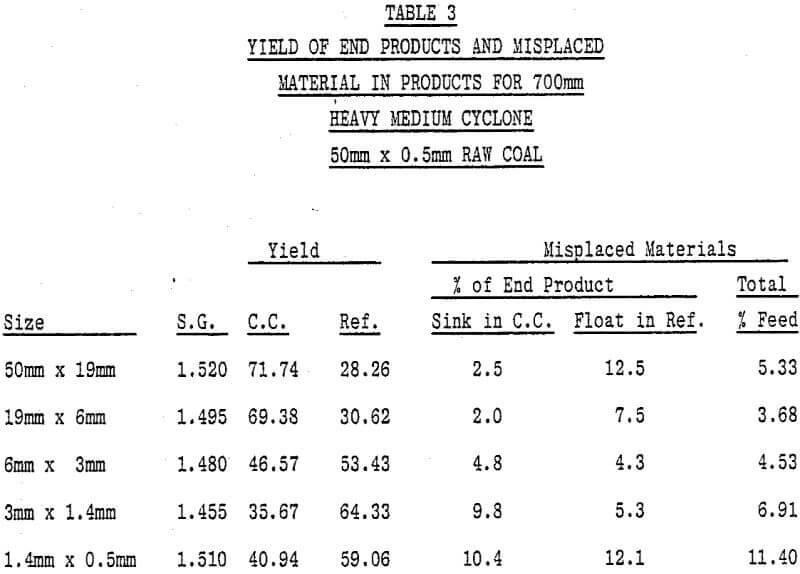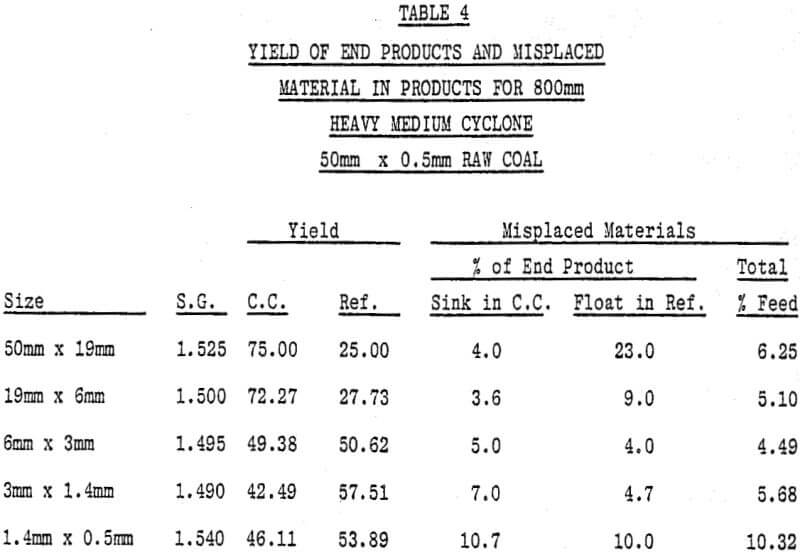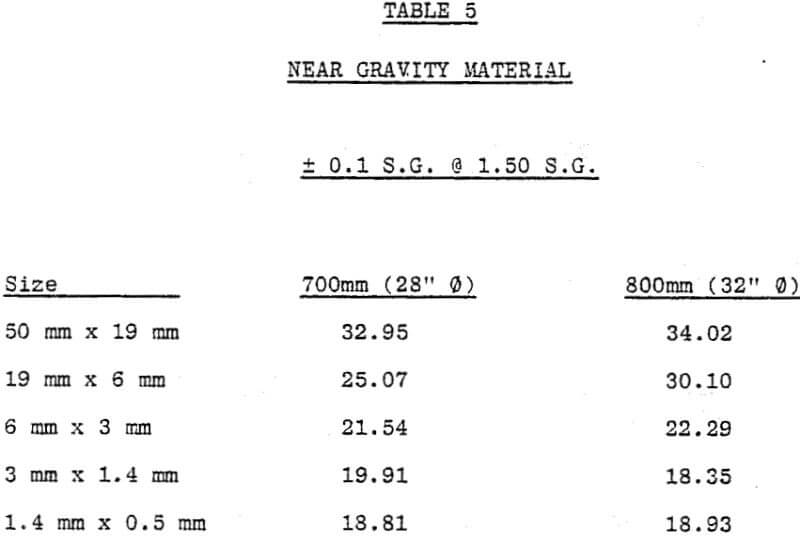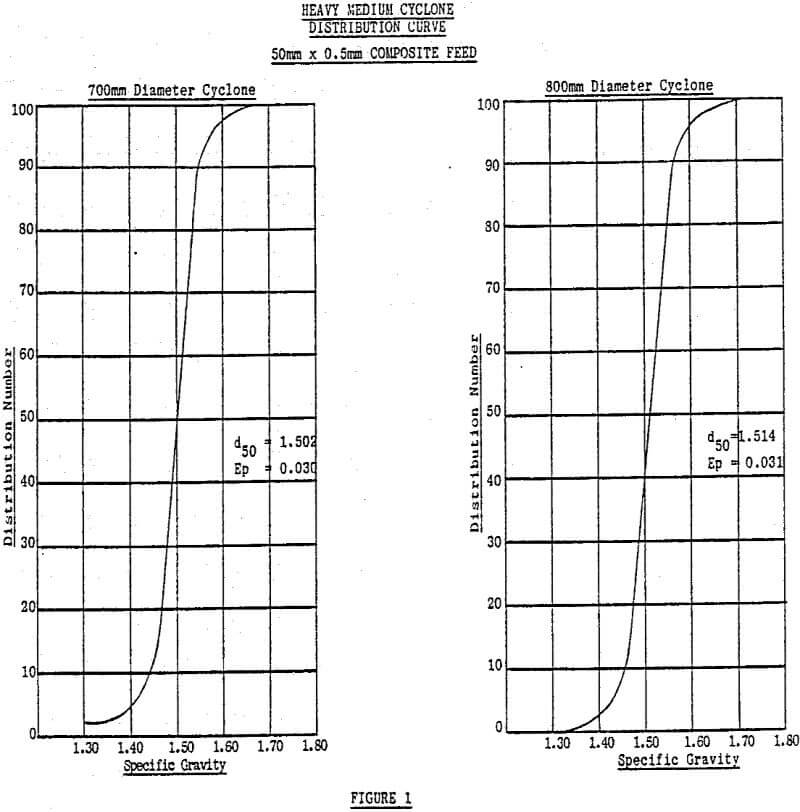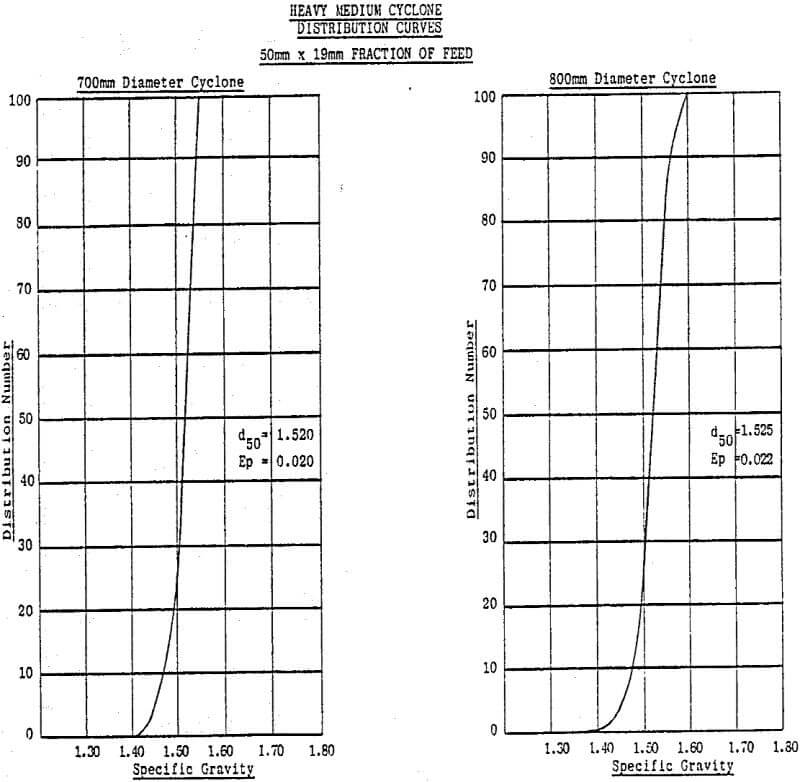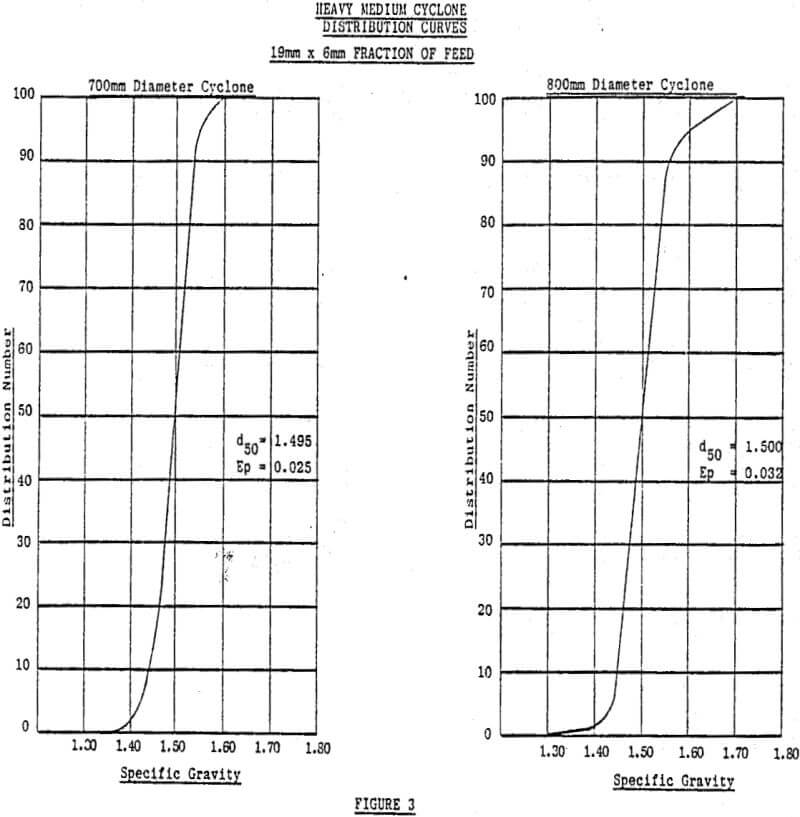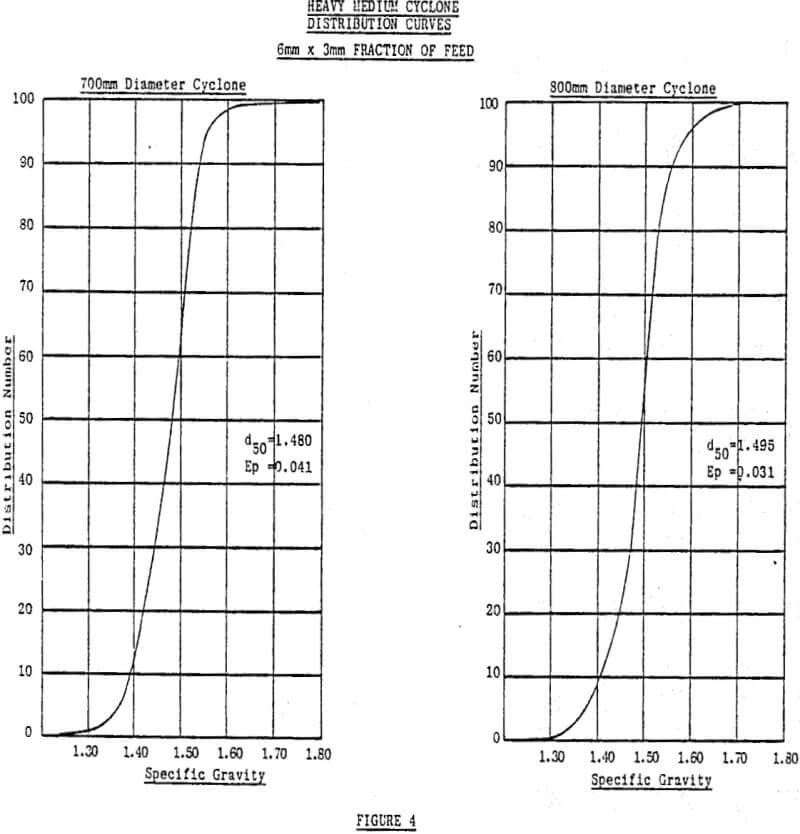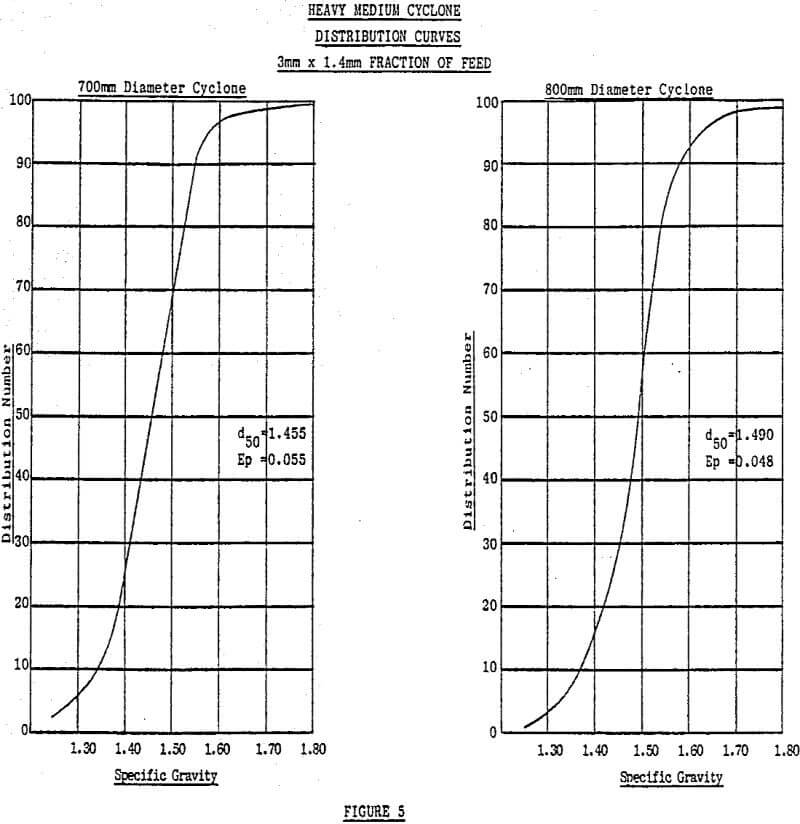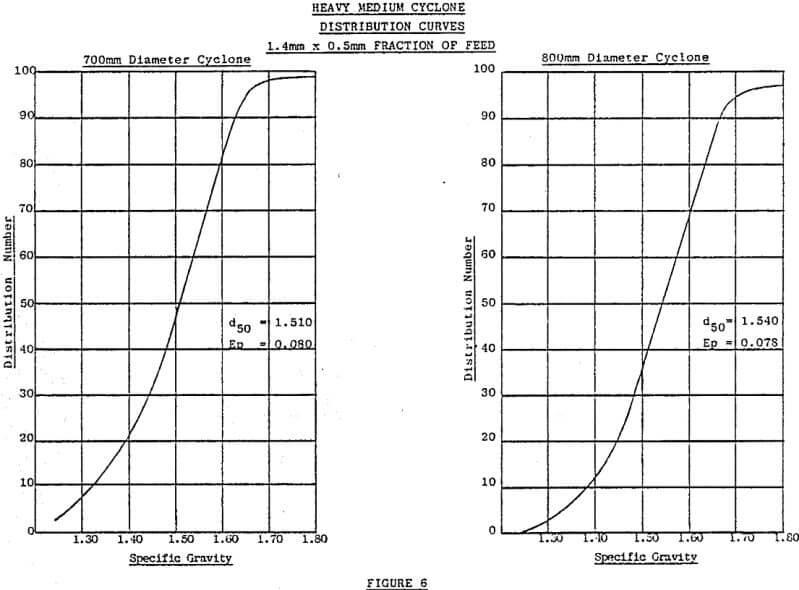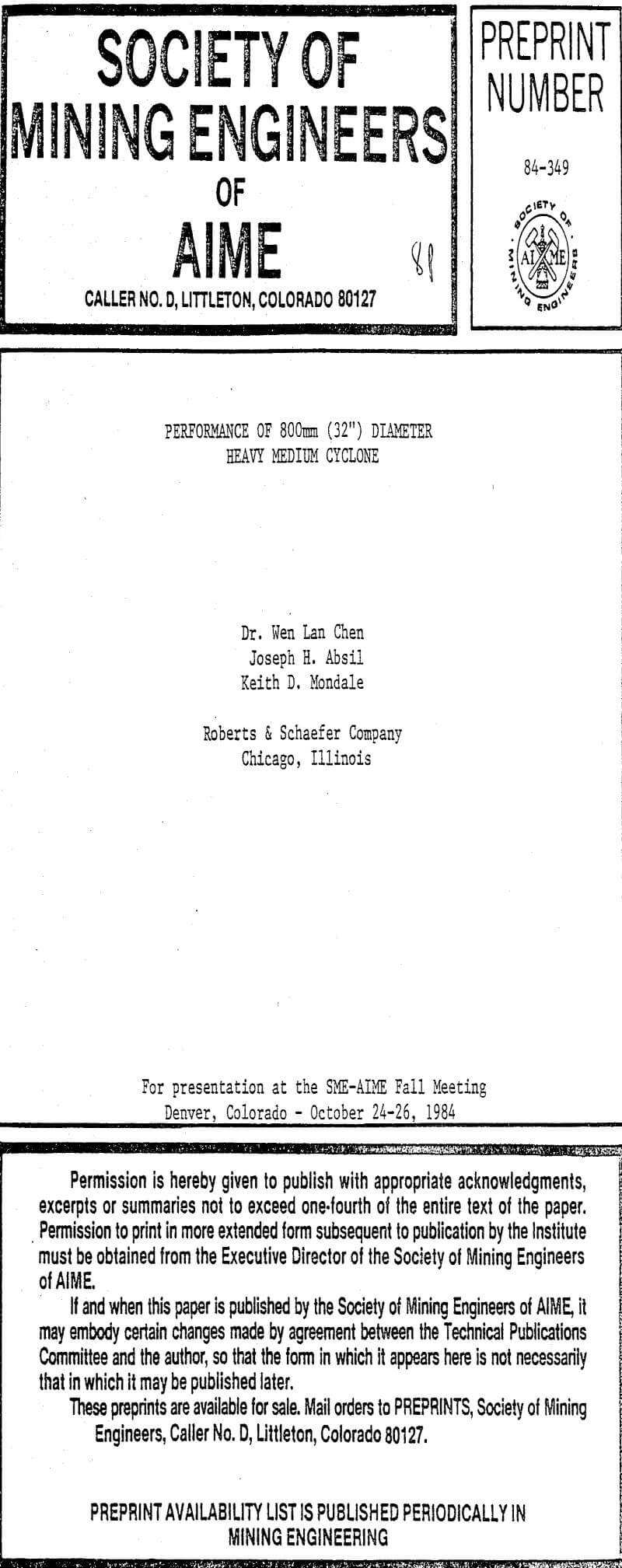From the early 1960’s until the mid 1980’s, dense medium cyclone circuitry design technology did not change appreciably. The basic design, which was both highly flexible and highly efficient, was consistent with technology developed by the Dutch State Mines (“DSM”) in the mid 1940’s. During this period, the “typical” dense medium cyclone circuit was designed to process raw coal in the 9.5 mm x 0.6 mm size range. Coarser coal was processed in dense medium vessels or jigs, and the fines were processed in spirals, water-only cyclones, or flotation.
The past years have witnessed a significant extension in state-of-the-art dense medium cyclone circuitry design. Dense medium cyclones are rapidly becoming a common choice for cleaning a much broader size range of raw coal than considered economically feasible just a few years ago. From a nominal top size of 63.5 mm to 76.2 mm down to 0.15 mm dense medium cyclones have been shown to be capable of operating economically and over a narrow range of efficiencies. This remarkable extension of the feed size range considered appropriate for dense medium cyclone cleaning is primarily a function of the following:
- An improved understanding of how cyclone configuration and operating conditions (including magnetite characteristics) impact cyclone efficiency;
- Improvements in the design of the ancillary equipment and systems (screens and magnetic separators); and
- Advances in process instrumentation and control methodology.
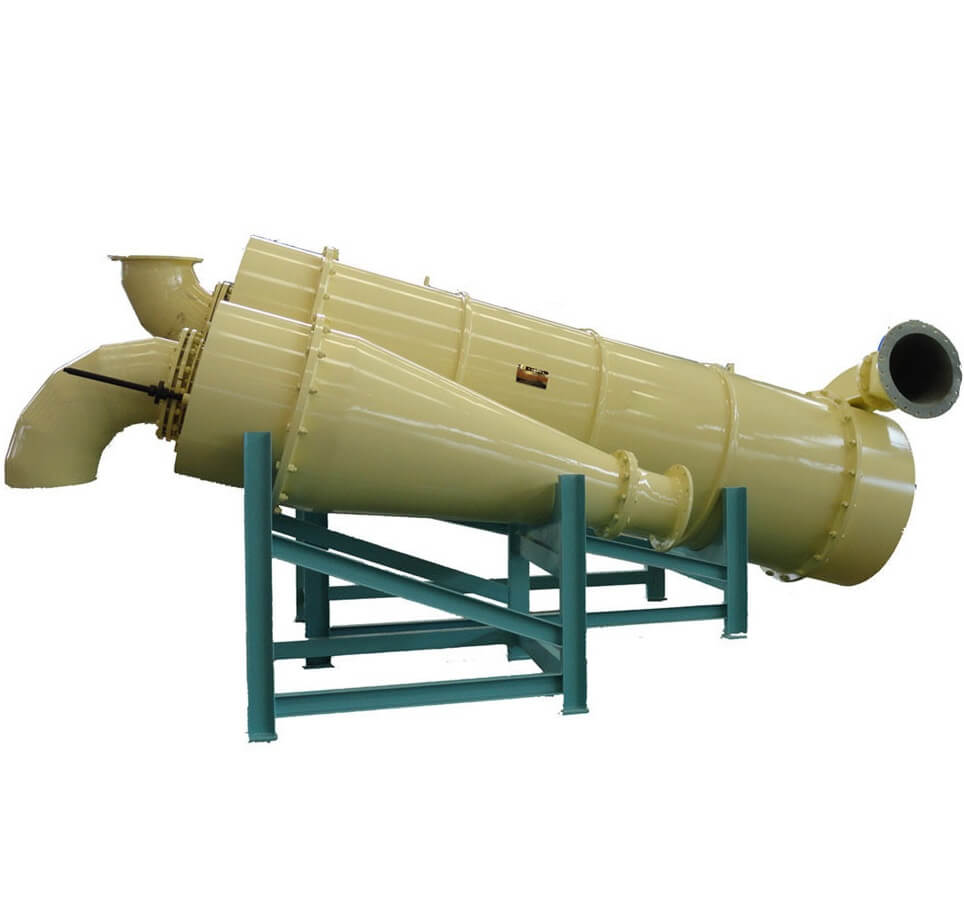
Recent improvements in equipment design, coupled with innovative approaches to the control of the specific gravity of the medium in dense medium cyclone circuits, have made possible all of the following:
- An extension of the size range of raw coal for which dense medium cyclones may be cost- effectively utilized;
- Improvements in raw coal desliming screen efficiency and unit capacity which have made dense medium cyclone circuitry less expensive to install.
- Improvements in drain and rinse screen efficiency and unit capacity which have decreased magnetite consumption and the operating cost of dense medium cyclone circuits;
- Advancements in magnetic separator design and operation which have decreased magnetite consumption and reduced the operating cost of dense medium cyclone circuits; and
- Specific gravity control systems that perform more precisely and allow the dense medium cyclones to perform at optimum efficiency.
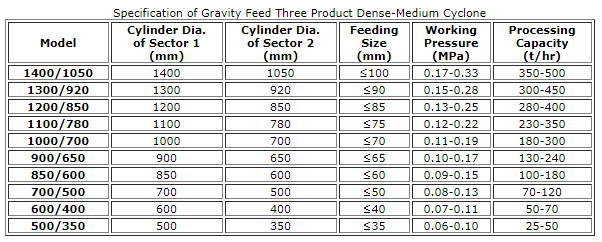
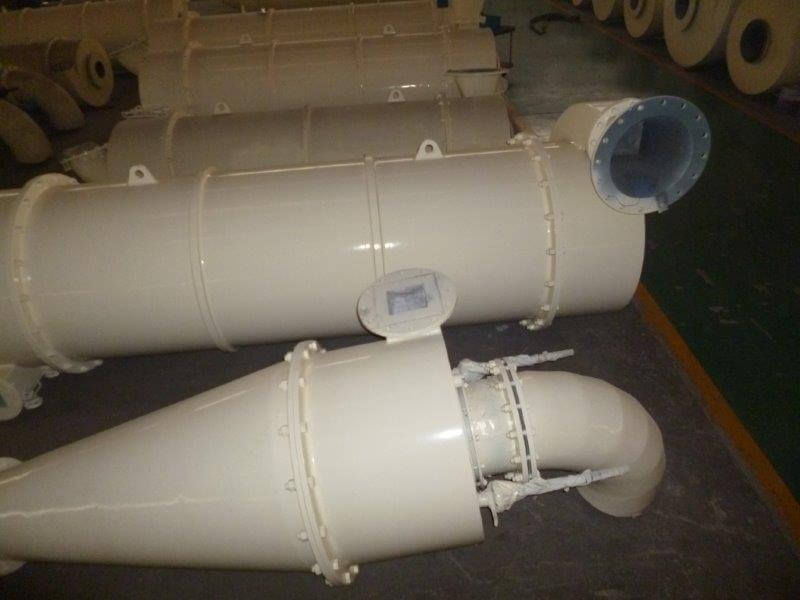
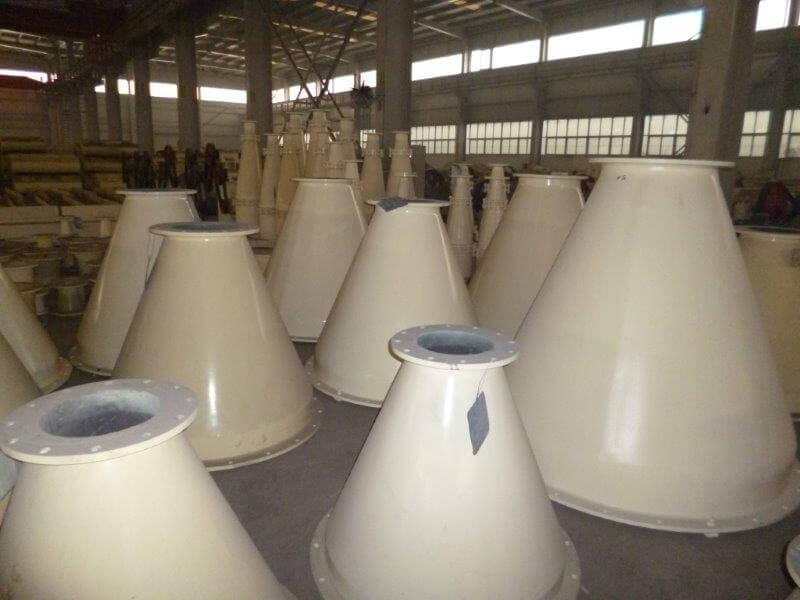
Cyclone Configuration and Operating Conditions
The impact of cyclone configuration on separating efficiency has become more clearly understood as a result of test work conducted at the Homer City Coal Cleaning Plant in Pennsylvania, as well as research undertaken at coal cleaning facilities in Australia, South Africa, and elsewhere. Cyclone configuration includes the diameter of the cyclone, apex diameter, vortex finder length and diameter, and the ratio between apex diameter and vortex finder diameter. Until quite recently, the largest dense medium cyclones provided diameters of about 710 mm with a maximum raw feed top size of 50 mm. With the exception of the so-called “washing to zero” plants with capacities generally in the range of 100 to 300 STPH, most cleaning plants continued to be designed with dense medium cyclones processing only a rather narrow size range, as depicted in Figure 1 (pre-1985). A typical dense medium type coal preparation plant included dense medium vessel circuitry for the “coarse” raw coal, dense medium cyclone circuitry for the “intermediate” size fraction with a spiral (or water-only cyclone) circuit for raw coal down to about 0.15 mm Ultra-fines (0.15 mm x 0) were either discarded to refuse or processed in froth flotation circuits. Such a typical plant looked something like the schematic shown in Figure 2.
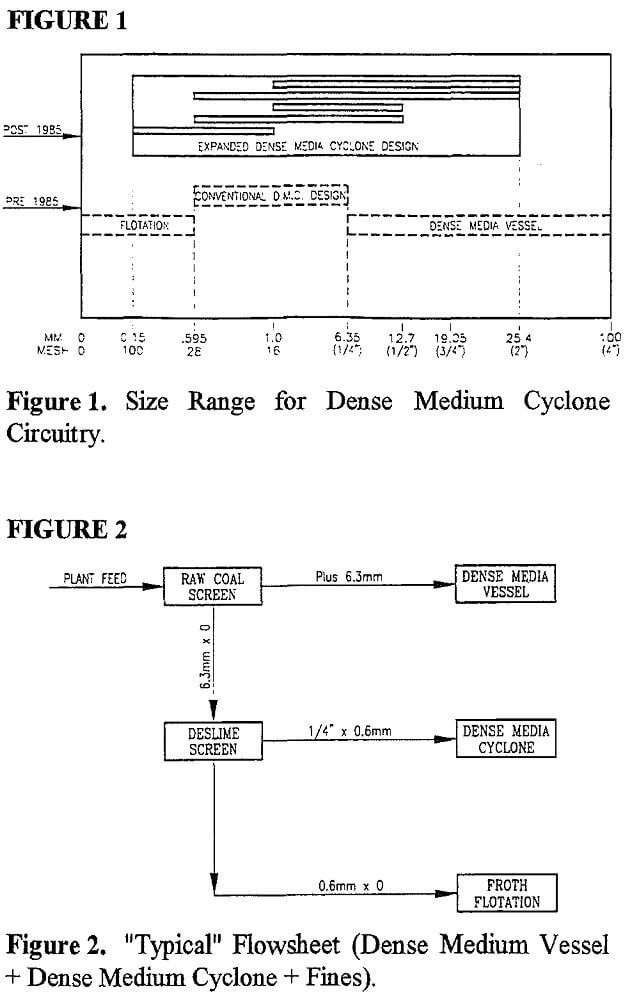
Beginning in about 1995, however, U.S. equipment manufacturers began to offer much larger cyclones to the coal industry. Units with diameters in excess of 900 mm capable of handling a top size in the range of 76 to 102 mm have been successfully installed in a number of coal preparation plants with excellent results. Table 1 illustrates the large capacity increases that can be achieved by using this new generation of dense medium cyclones.
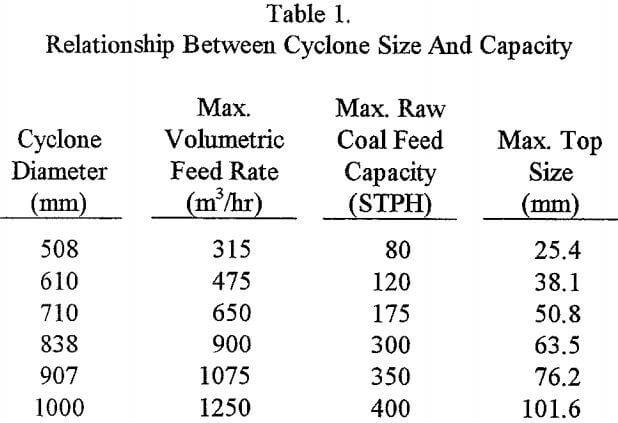
In addition to greater throughput, with obvious advantages in reducing the number of units required to handle a given quantity of raw coal, these large cyclones make it feasible in some cases to eliminate the dense medium vessel circuit entirely. The result is a simplified flowsheet with savings in space requirements and piping. Figure 3 illustrates a typical cleaning plant in which dense medium cyclones are used to process raw coal from a top size of 50 mm down to 1.0 mm
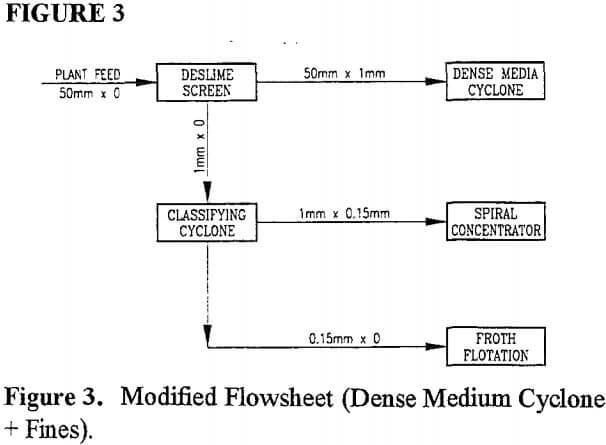
To be cost-effective, it is critical that the operating parameters in a dense medium cyclone circuit such as the one shown in Figure 3 be closely monitored and controlled. The parameters of most concern include the following:
- Medium-to-coal ratio.
- Medium purity.
- Magnetite size distribution.
- Cyclone inlet feed pressure.
In most cases, the appropriate medium-to-coal ratio is determined by the coal preparation plant builder during the conceptual design phase of the project. Most dense medium cyclone circuits in the United States are operated with medium-to-coal ratios of 3:1 to 4:1, by volume. Coal preparation plant designers often use the lowest medium-to-coal ratio consistent with an acceptable level of cleaning efficiency. Generally, medium-to-coal ratios should be increased as the percentage of near-gravity material increases, i.e., in middlings circuits or in applications where a low specific gravity of separation (1.45 or below) is required to produce a product meeting customer specifications. The writers believe a 4:1 ratio is most appropriate for separations where near-gravity material is less than 30% and a 5:1 ratio (or higher) should be used when the near- gravity exceeds 30%.
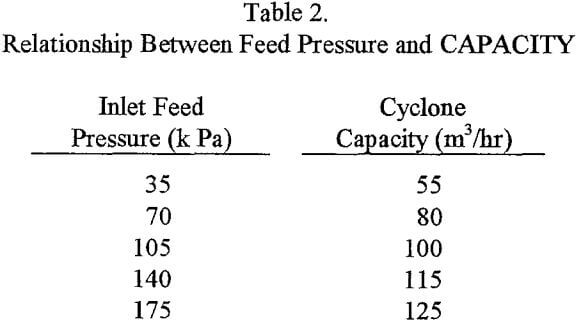
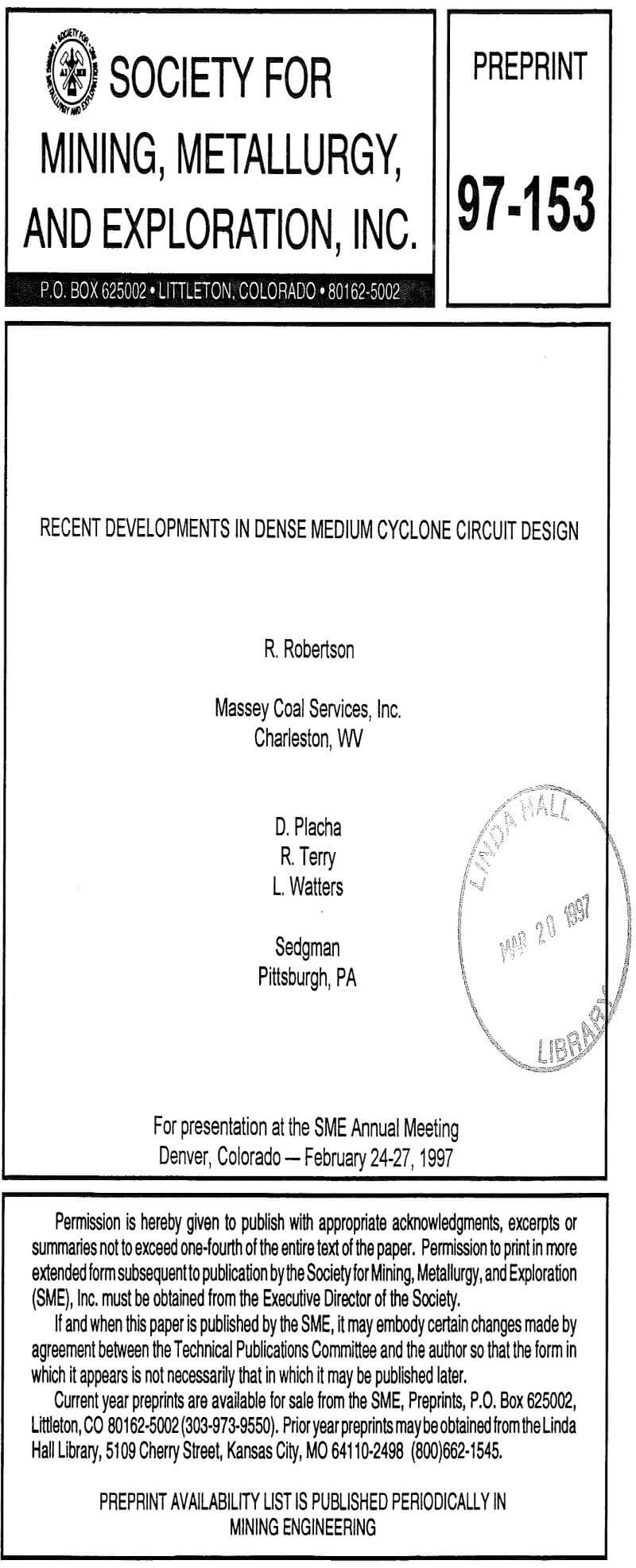
Contamination of the recirculating medium can be a problem in any dense medium cyclone circuit, and the adverse impact of even relatively small amounts of non-magnetic contamination in the medium is understood.
The problems created by such contamination are intensified as the specific gravity of separation decreases and the percentage of near-gravity material in the feed increases.
As non-magnetics (including ultra-fine coal, clays, and other ultra-fine non-bituminous particles) replace magnetite particles in the recirculating medium, the viscosity of the medium increases and cyclone performance suffers. It is especially important that ultra-fine magnetite particles (<10.0 µ) be retained in the medium since a finer magnetite particle size distribution results in a more stable cyclone operation and improved cyclone efficiency. In one set of tests intended to quantify the impact of size distribution on efficiency, the percentage of ultra-fine (>5.0 µ) particles was increased incrementally from 10% to 20% and probable error values were determined for each increment. The probable error value was 0.08 when the percentage of ultra-fines was 10%. This value decreased in a straight- line relationship to a value of 0.03 when the percentage of ultra-fines reached 20%, the upper limit of the test. Systems have been developed to minimize medium contamination while maintaining an acceptable grain size distribution.
Cyclone inlet feed pressure determines the volumetric flow rate through the dense medium cyclone, and higher pressures result in higher flows through a cyclone of given geometry. This relationship is shown in Table 2 for a 350 mm diameter cyclone.
Just as the volumetric flow rate increases with elevated inlet feed pressure, so, too, does the classification effect occurring within the cyclone. This classification effect can have an appreciably negative impact on dense medium cyclone performance. This deterioration in performance becomes more pronounced as the separating gravity decreases. In at least one instance, where feed pressure was held constant, relatively large diameter cyclones produced better separations than smaller units at a specific gravity of separation of about 1.30. For example, a cyclone 500 mm in diameter achieved a probable error of about 0.05 while the probable error produced by a much smaller cyclone (200 mm) was significantly higher (approximately 0.09).
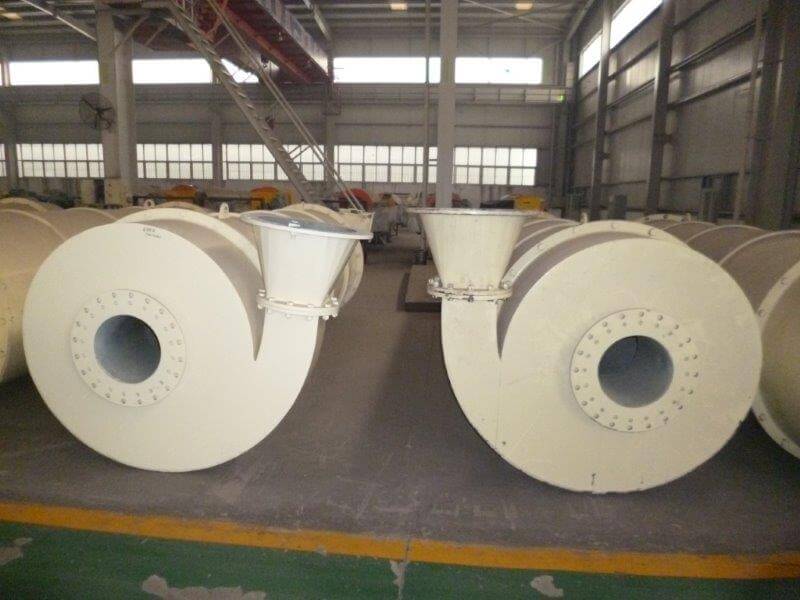
Heavy Medium Cyclone Performance
In the plant where the 800mm diameter cyclone was tested, 500 STPH of 50mm x 0 raw coal was pulped in a heavy medium tank and pumped originally to four 700mm heavy medium cyclones. For the test one of these units was replaced by an 800mm diameter cyclone with the subsequent feed pressure for both units sets at approximately 15.0 psi.
With the exception of the finest size fraction, this table also shows that the coarsest fraction in both cyclone feeds was separated at a higher separating gravity than those of successively finer sizes as well as the overall composite. This has been observed in some instances where the size range of the feed to the cyclone becomes broad.
The size distribution of the raw feed plays an important part in the overall cleaning performance of any cyclone. As the feed becomes finer, performance will deteriorate for a given diameter of cyclone. This situation is particularly enhanced for cyclones of larger diameters. As such, an increase in pumping rates to these larger cyclones to provide added centrifugal force to restore their sharpness of separation (cleaning efficiency) may create excessive wear in these units.
